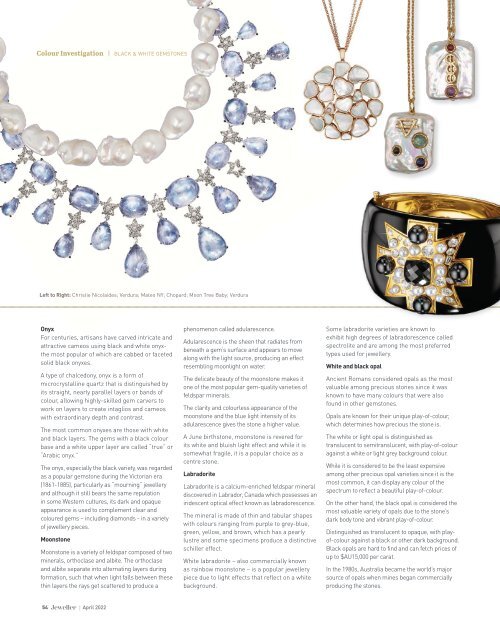Jeweller - April 2022
Diamond disruption: How the Russia-Ukraine conflict is changing global trade High time for change: Where to for watch brands after Baselworld? Darkness & light: Uncover the mysteries of black and white gemstones
Diamond disruption: How the Russia-Ukraine conflict is changing global trade
High time for change: Where to for watch brands after Baselworld?
Darkness & light: Uncover the mysteries of black and white gemstones
Create successful ePaper yourself
Turn your PDF publications into a flip-book with our unique Google optimized e-Paper software.
Colour Investigation | BLACK & WHITE GEMSTONES<br />
Left to Right: Christie Nicolaides; Verdura; Mateo NY; Chopard; Moon Tree Baby; Verdura<br />
Onyx<br />
For centuries, artisans have carved intricate and<br />
attractive cameos using black and white onyxthe<br />
most popular of which are cabbed or faceted<br />
solid black onyxes.<br />
A type of chalcedony, onyx is a form of<br />
microcrystalline quartz that is distinguished by<br />
its straight, nearly parallel layers or bands of<br />
colour, allowing highly-skilled gem carvers to<br />
work on layers to create intaglios and cameos<br />
with extraordinary depth and contrast.<br />
The most common onyxes are those with white<br />
and black layers. The gems with a black colour<br />
base and a white upper layer are called “true” or<br />
“Arabic onyx.”<br />
The onyx, especially the black variety, was regarded<br />
as a popular gemstone during the Victorian era<br />
(1861-1885), particularly as “mourning” jewellery<br />
and although it still bears the same reputation<br />
in some Western cultures, its dark and opaque<br />
appearance is used to complement clear and<br />
coloured gems – including diamonds - in a variety<br />
of jewellery pieces.<br />
Moonstone<br />
Moonstone is a variety of feldspar composed of two<br />
minerals, orthoclase and albite. The orthoclase<br />
and albite separate into alternating layers during<br />
formation, such that when light falls between these<br />
thin layers the rays get scattered to produce a<br />
phenomenon called adularescence.<br />
Adularescence is the sheen that radiates from<br />
beneath a gem’s surface and appears to move<br />
along with the light source, producing an effect<br />
resembling moonlight on water.<br />
The delicate beauty of the moonstone makes it<br />
one of the most popular gem-quality varieties of<br />
feldspar minerals.<br />
The clarity and colourless appearance of the<br />
moonstone and the blue light intensity of its<br />
adularescence gives the stone a higher value.<br />
A June birthstone, moonstone is revered for<br />
its white and bluish light effect and while it is<br />
somewhat fragile, it is a popular choice as a<br />
centre stone.<br />
Labradorite<br />
Labradorite is a calcium-enriched feldspar mineral<br />
discovered in Labrador, Canada which possesses an<br />
iridescent optical effect known as labradorescence.<br />
The mineral is made of thin and tabular shapes<br />
with colours ranging from purple to grey-blue,<br />
green, yellow, and brown, which has a pearly<br />
lustre and some specimens produce a distinctive<br />
schiller effect.<br />
White labradorite – also commercially known<br />
as rainbow moonstone – is a popular jewellery<br />
piece due to light effects that reflect on a white<br />
background.<br />
Some labradorite varieties are known to<br />
exhibit high degrees of labradorescence called<br />
spectrolite and are among the most preferred<br />
types used for jewellery.<br />
White and black opal<br />
Ancient Romans considered opals as the most<br />
valuable among precious stones since it was<br />
known to have many colours that were also<br />
found in other gemstones.<br />
Opals are known for their unique play-of-colour,<br />
which determines how precious the stone is.<br />
The white or light opal is distinguished as<br />
translucent to semitranslucent, with play-of-colour<br />
against a white or light grey background colour.<br />
While it is considered to be the least expensive<br />
among other precious opal varieties since it is the<br />
most common, it can display any colour of the<br />
spectrum to reflect a beautiful play-of-colour.<br />
On the other hand, the black opal is considered the<br />
most valuable variety of opals due to the stone’s<br />
dark body tone and vibrant play-of-colour.<br />
Distinguished as translucent to opaque, with playof-colour<br />
against a black or other dark background.<br />
Black opals are hard to find and can fetch prices of<br />
up to $AU15,000 per carat.<br />
In the 1980s, Australia became the world’s major<br />
source of opals when mines began commercially<br />
producing the stones.<br />
54 | <strong>April</strong> <strong>2022</strong>


















